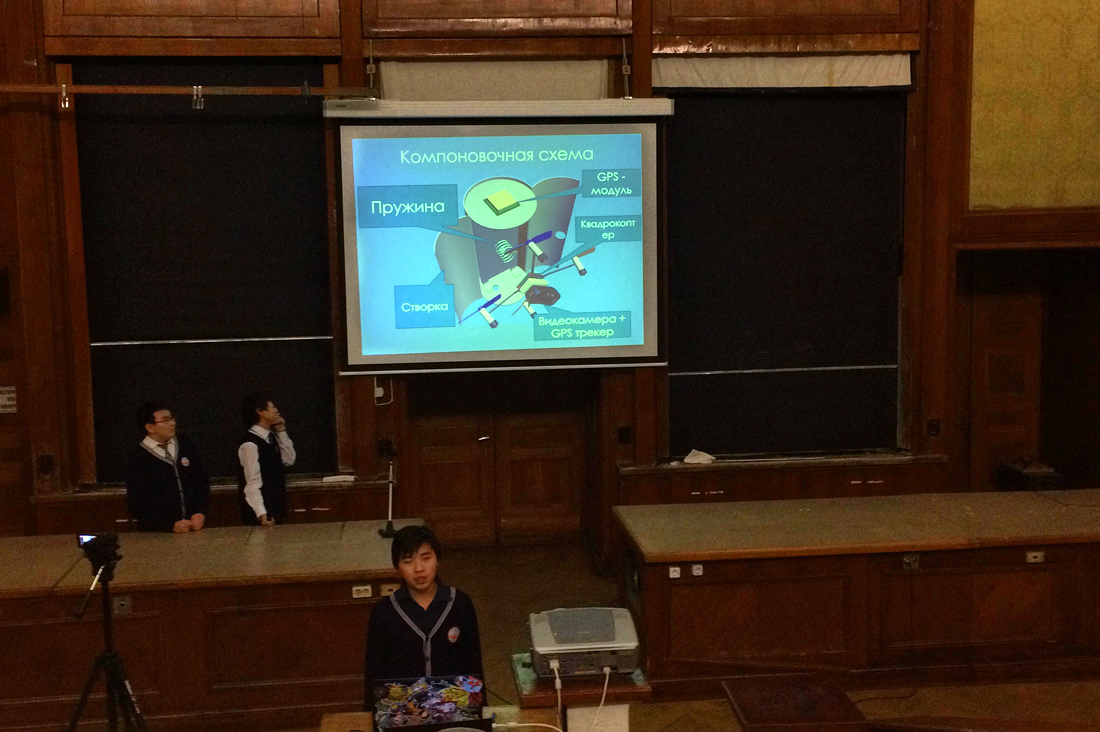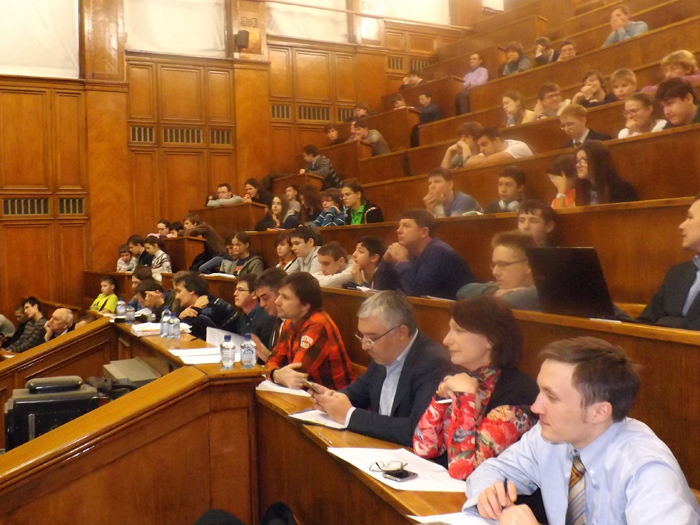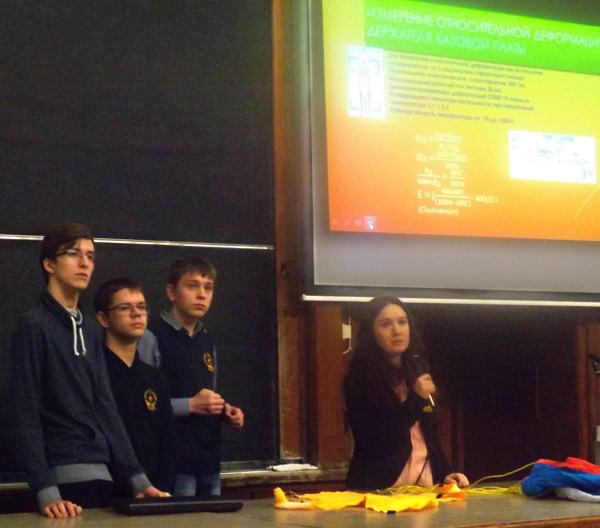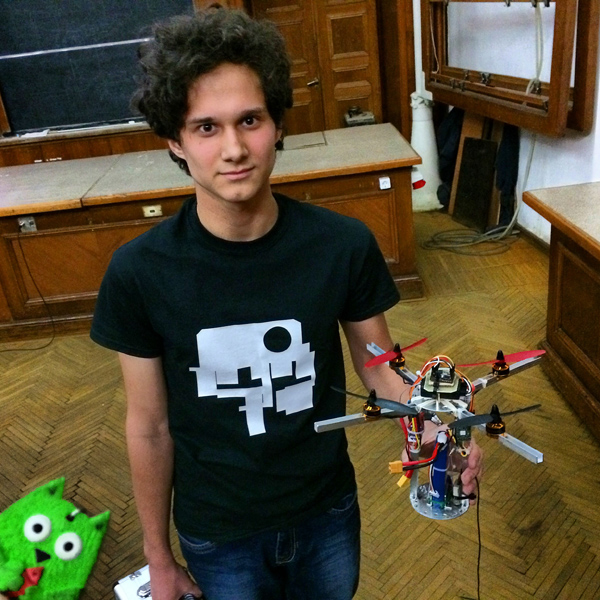Satellite makers are not born

Is it difficult to create a spacecraft? Develop a design, layout, place all sensors, payload, data transmission tools, work out the electrical circuit, take into account all loads, vibration, thermal effects ... And meet the deadlines, weight, dimensions and cost.
Practically all these tasks are to be solved by the participants of the school championship "KanSat in Russia", which is organized by the Research Institute of Nuclear Physics of Moscow State University, with the support of " Dauria Aerospace ".
Yesterday I visited the winter test session, where participants reported on the work done, talked about the results achieved, demonstrated the performance of on-board software, and their readiness for the summer practical stage.

')
A bit of history: the CanSat championships were invented by NASA more than 10 years ago. The name translates as “satellite in a bank”, which accurately reflects the essence of the competition - the creation of an automatic device, the size of a can of cola, which can perform functions corresponding to the functions of the spacecraft: autonomous work, obtaining data on the environment, conducting experiments, and remote transmission of information . The “satellite in the bank” is launched by a rocket to a height of several kilometers, and, during a descent by parachute, it transmits data to a ground station. Such championships are a useful training and preparation of the younger generation for the unmanned exploration and exploration of space. Now CanSat is held in dozens of countries around the world, and groups that create scientific or commercial spacecraft are already growing from some of the participating teams.
“KanSat in Russia” is a “local” Russian event, which is not directly connected with a foreign CanSat. In the Russian championship, the rules have been slightly changed, for example, vehicles are built not on the basis of a can 0.33, but in the size of a can 0.5. Due to the difficulty of coordinating rocket launches to great heights, we find alternative options: launching “satellites” from helicopters, balloons, quadcopters. In the summer of 2015, launches from the stratostat are planned from a height of 30 km.
It is still a long way before summer, so for the time being it was necessary for the participants to report on a theoretical study of the project: prepare a presentation in which to reflect the goals and objectives of the mission, a scientific and practical justification, and demonstrate the degree of readiness for the project. But some teams still tried to show their practical groundwork: someone showed ready-made parachute concepts, someone - software performance, someone - working technological samples.
The jury was selected strict and serious: there were representatives of INP MSU, United Rocket and Space Corporation, Dauria Aerospace, Agency for Strategic Initiatives, Fifth Generation Design Bureau, NearSpace community.

At the presentations, the children were not spared; both the jury members and direct competitors from other teams asked questions. Scientific supervisors did not have the right to help, only gesticulated and bit his lip - like sports trainers during a match. At such moments, another stage in the preparation of real developers of space technology is underway - the public defense of the project. The engineer has little to invent a unique product, he must also prove his uniqueness, convince investors, the grant committee and / or the state commission that his work is worth launching into a series or launching into orbit. And here it is important not only the exact mathematical calculation, but also the ability to speak in public, orientation in all the technical and practical nuances of the project, readiness and ability to clearly explain why certain technical solutions are chosen. All this is a real deal, and a real job that is needed in the space industry. I don’t know if they are preparing this in core institutions, but, as I saw, not all engineers are ready for it. “KanSat in Russia” provides an opportunity to practice.
The readiness of the teams was very different. Someone was frankly weak in the presentation part, someone on the contrary relied on artistry and colorful presentation, playing in the technical study of the project. We were pleased with the Moscow team of school No. 17, where the captain confidently drove four guys-techies, and the jury answered the questions:
“I'll show you now,” and went to draw diagrams on the blackboard or drive teams into the program for receiving and processing telemetric information. Those. as a real project manager, she was aware of all the details, and readily defended the decisions of the team’s specialists.

Interesting technical projects were in the Yakut team “Cholbon-B” and in Kazan “Gagarin v2”.
Schoolchildren of Sakha-Yakutia decided to diversify the classic layout of the “satellite”. They managed to pack in the dimensions of the can also a folding amphibter quad. The launch scheme was as follows: the rocket starts and, at the highest point of its trajectory, shoots a “satellite”; he descends by parachute, transmits information about his location, and at the height of 200 meters his flaps open and an automatic quadrocopter flies out from there: he describes a circle, carrying out video recording, and lands.
The team from Kazan struck no less exotic design - they generally abandoned the parachute, and in his role decided to use a quadrocoper. Those. The “satellite” at the stage of descending produces four aluminum “beams” with propellers, due to the operation of the engines, the fall of the vehicle turns into a gradual decline, several times slower than parachute descent. At the stage of reduction, an infrared camera is turned on, which allows you to scan the terrain for heat sources - the guys in the technical rationale prescribed a search for hot spots in the peat bogs.

Kazan did not just talk about their project, but also prepared an engineering model of the device. In the process of a demonstration of the jury of its capabilities, one engine was burned down, then the other. To which the guys phlegmatically stated:
- Well, during the tests, we found out that the engines of this manufacturer should not be used in the flight model of the device.
In general, the event was inspiring, the children frankly pleased. Of course, the success of school teams is largely dependent on their leaders. If there is an enthusiastic teacher in the school, if he is engaged and transmits his hobby to the pupils, then a new generation of space explorers leaves the school. And further, the concern of the state is to give children the opportunity to get a higher education, find a job for the soul and realize themselves in their own country, in real and interesting things in space and on Earth.
“KanSat in Russia” is one of the few opportunities for students to try out their abilities in a matter related to astronautics. There are also various robotic championships and festivals, like “Robosiba”, which I managed to attend. But, as always, the possibilities are limited. The teams themselves decide to move to the venue of the championship, attract sponsors and the help of local authorities. The geography of KanSat participants is wide - from the Far East to Murmansk, even neighbors from Belarus come. Despite this, organizational costs often go beyond the sponsorship, so if anyone has the desire and opportunity to join the support and development of the championship - write , add , we are glad of any real help.
Source: https://habr.com/ru/post/365063/
All Articles